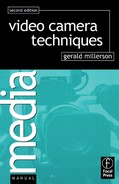Before rehearsals start, let’s take a look at some very worthwhile checks that can anticipate problems. First of all, identify the various action areas. Some will be self-evident: the office, the kitchen. But suppose there are several interview or performance areas? Which is which? Often they will be given identifying letters (e.g. ‘Area A’) or names.
Referring to your camera card, locate the various main camera positions and moves. Are there any obvious problems? Perhaps there is some obstruction just where the dolly will be operating. It does happen: insufficient room to get between two flats, some temporarily stored props, a lighting fitting in the way. Check around. Perhaps you can see that a spotlight on a stand outside a room window, will be in shot from one of your positions. Observation now saves time later.
There may be a single communal wall-box for all cameras’ outlets; or duplicate points around the studio, allowing you to use whichever is nearest to your main action area.
In a major studio production the best floor route for your camera’s cable to take as it runs from the wall outlet (plugging point) to each main viewpoint, is marked on the show’s camera plan (Camera 2 will be at positions 2A, 2B, 2C, etc.). That avoids unnecessary cable runs stretching across the studio floor, impeding other cameras’ movements.
Camera cables can get trapped under scenic flats, floor monitors or loudspeakers, furniture, etc. So make sure that you have enough free cable for your moves. Keep any surplus piled in a neat figure-of-eight coil in an out-of the-way spot behind scenery. It is not only frustrating to strain against tight or snarled-up cable, but liable to damage the cable too.
It’s a good idea to look around the studio floor surface in areas where you will be dollying your camera. There may be odd obstacles during early rehearsal – ranging from cables (lighting, monitors), lumber used in last-minute construction, carpets, even wet floor paint – that could upset smooth dolly moves. The floor needs to be clean, too. A dropped cigarette butt has stuck to a dolly wheel before now, and caused camera judder!
Finally, let’s move to the opening camera position. On with the headset, just look over the camera cards (shot sheet) or run-down sheet, focus up on the scene, and you’re ready to go!
Floor check
There are often various problems for the unwary, including:
(1) Camera cable trapped. (2) Water on the floor. (3) Lighting cables that prevent dollying. (4) Floor covering that frustrates a dolly move. (5) Scenery that prevents camera getting into position.
Cable routing
In a continuous multi-camera production, it can be important to arrange camera cables carefully so that they do not prevent dollying. Typical arrangements include: working in another camera’s loop, working under another cable (best avoided) and parallel routing.

